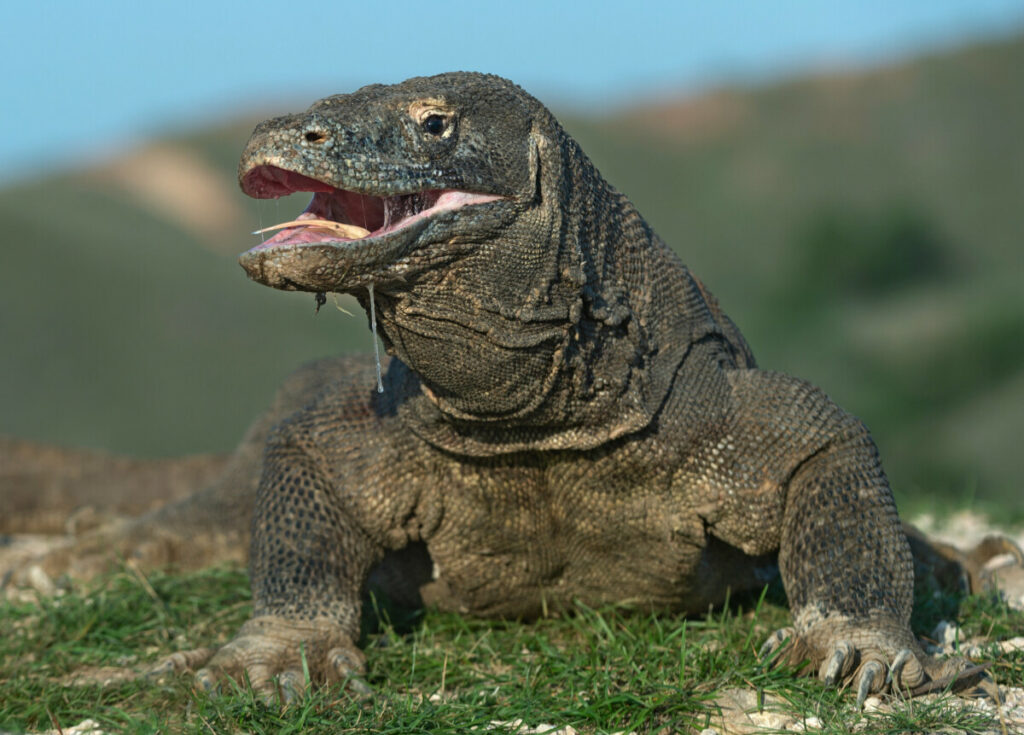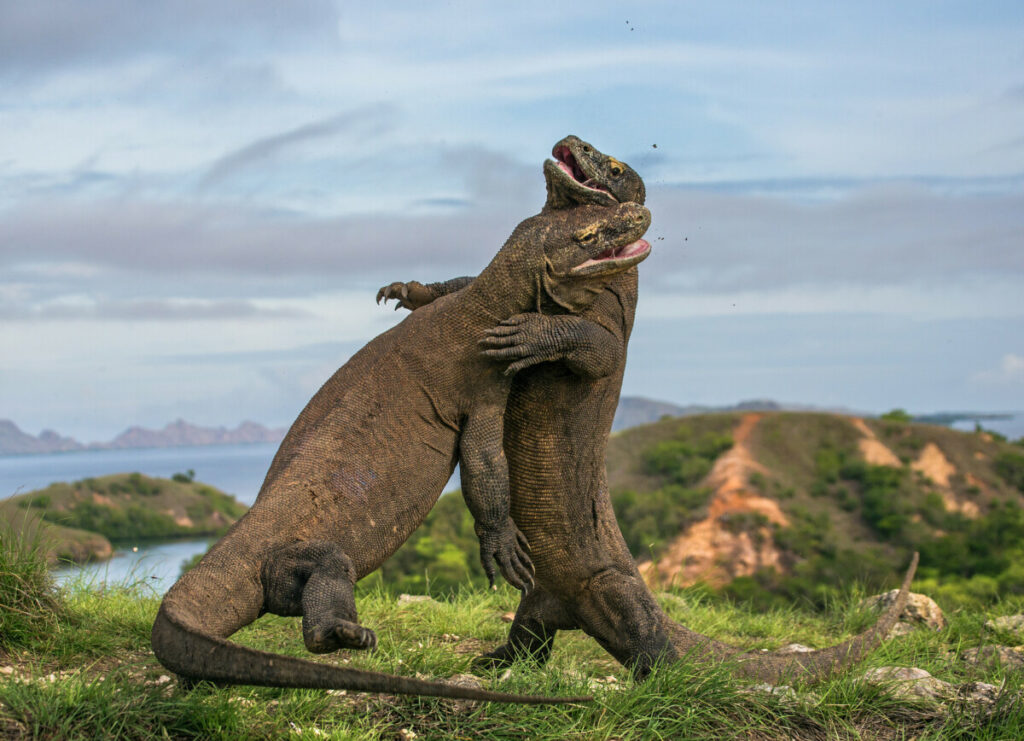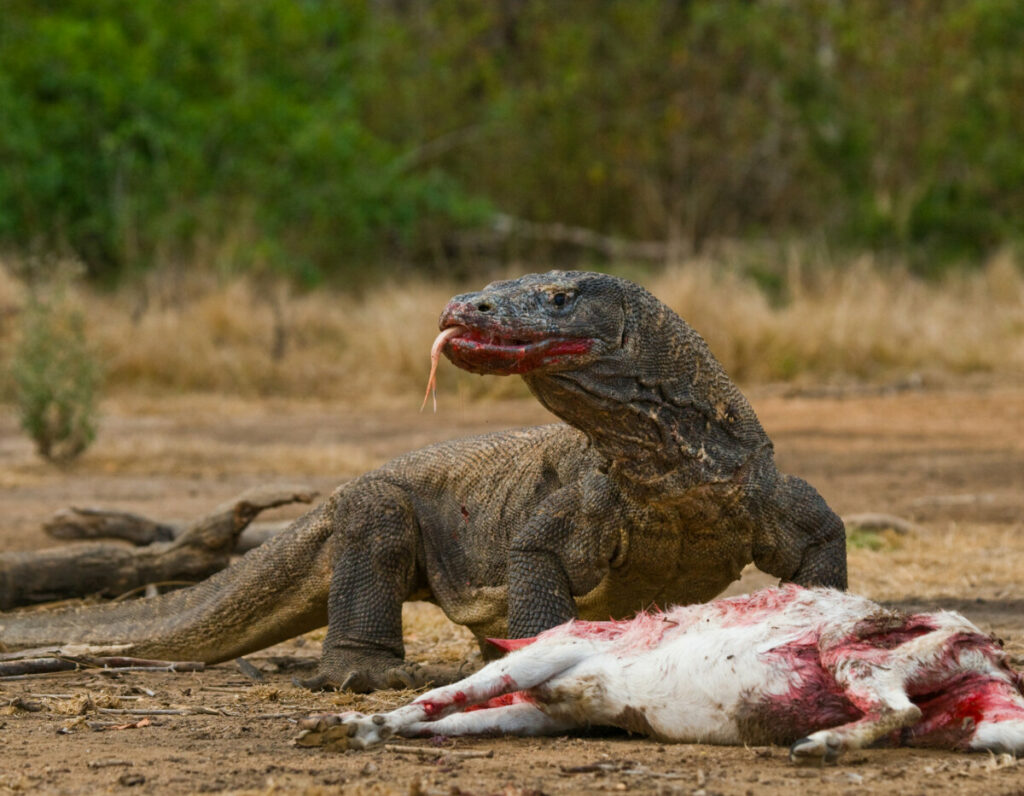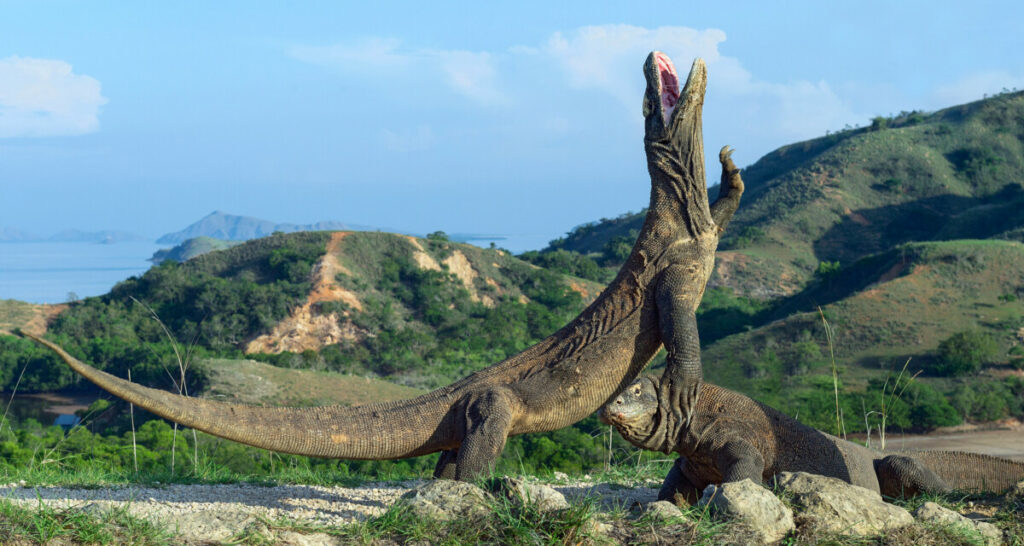
Many textbooks, studies, and articles on the Komodo dragons’ toxicity contain out-of-date information that has recently been proven false. Newer studies prove that this new theory is correct, and disproves what we have long thought to be true. That is whether or not Komodo Dragons are venomous or poisonous.
Komodo Dragons are venomous, injecting venom through a bite as one of the many tools used in killing their prey. Because these toxins are injected through biting rather than consumption or absorption through the skin, these creatures are classified as venomous rather than poisonous.
Unlike other venomous creatures, Komodo dragons do not rely solely upon their venom to kill and capture prey. They employ a variety of tools and tactics, only one of which being their venom, to capture each meal.
Many previously accepted theories on the predators have recently been disproven, opening a plethora of questions and validating new research that has provided the scientific and public communities with new facts and answers.
What Is the Difference Between Venom and Poison?
While the terms are often used interchangeably, venom and poison are not the same. Both contain toxins that can be harmful and even fatal when inflicted upon victims. The difference, however, lies in the method of delivery from the predator to the victim.
Poison enters the victim’s body through swallowing, inhaling, or physical contact that leads to the skin’s absorption of the poison. As opposed to venomous animals, poisonous creatures use their toxins as a form of defense rather than a method of attack.
For example, the poison dart frog has poison in its skin which is secreted and poisons its enemy when consumed or touched. It poisons those who intend to harm it rather than the potential prey the frog seeks out on its own.
Poisonous plants, such as stinging nettle, hogweed, poison ivy, and pain bush act in a similar manner. They poison predators through absorption in the skin upon contact.
Venom is classified by injection through bite or sting. It requires a wound to enter the body and is most effective when successfully entering the bloodstream. Consequently, venomous animals are far more prone to attack when searching for prey and defending themselves than poisonous animals.
One drop of venom from an inland taipan snake can kill up to 100 adult men and works in less than 45 minutes once injected.
Komodo Dragons Are Venomous But Not Poisonous
Komodo dragons inject their venom into their prey’s bloodstream upon bite, which then slows the animal to a gradual demise. Sometime after biting the animal, Komodo dragons are able to consume their victims.
There are a few select species that are both venomous and poisonous: making them significantly more dangerous than their competitors that contain only a single threat in the toxin department.
One example of this is the Asian tiger snake which injects venom through biting but also stores poison collected from prey that it secretes from its skin. The blue-ringed octopus also earns its place in this double-threat category. They are venomous through a bite with their beak, but also poisonous when eaten.
Komodo Dragon Venom vs. Mouth Bacteria
In 1969, an American biologist by the name of Walter Auffenberg studied Komodo dragons in Indonesia. Through observation of the creatures in action, Auffenberg concluded that the animals use bacteria in their mouths as a type of venom, which causes the slow debilitation and eventual capture of the animal’s victims and prey.
This observation and suggested hypothesis brought Auffenberg fame, an award, and even led to his novel on Komodo Dragons published in 1981. It is a theory now found in textbooks and articles throughout the world, but after three decades of research, it has finally been put to rest.
In 2009, Bryan Fry proved Auffenberg’s theory to be no more than an “enchanting fairytale”. Fry’s research proves that Komodo dragons possess and employ true venom when attacking their prey, rather than alleged bacteria to simulate it.
Fry and other researchers at the University of Melbourne in Australia were able to discover the truth about the animal’s venom when given a unique opportunity. Two Komodo dragons in a zoo were terminally ill, and the researchers were able to study the dragons for a time before their deaths.
Komodo Dragons Where Found To Have True Venom
Through their research, it was concluded that the animals have glands in their mouths containing venom that is as potent as that of the world’s most venomous snake! The venom reduces blood pressure rapidly, stops blood clotting, and increases blood loss exponentially.
The team, however, did not stop there. Fry and his colleagues contacted numerous zoos that house Komodo dragons and received permission to include the animals in the research of their mouths. They collected samples from 10 adult dragons and 6 hatchlings and studied their mouth bacteria.
Contrary to prior beliefs, the animals’ mouths were proven to contain much fewer bacteria than carnivores of their caliber generally possess. The microbes were easily traced back to their recent meals, and there were certainly not any capable of causing such a fatal impact on their enemies upon attack.
This study further supported the newly proven theory that the animals did not contain harmful mouth bacteria as previously claimed by Auffenberg. It is confirmed that Komodo dragons are, indeed, venomous and use this as a method of attack when hunting prey.

Do Komodo Dragons Have Venomous Glands?
Far from bacteria in their mouths as originally believed, Komodo dragons have venomous glands located in their lower jaws. While most venomous creatures use a single glad to store venom and deliver it through their fangs, Komodo dragons have multiple ducts that release venom between their teeth.
Because of this difference, the dragons are unable to deliver their venom as efficiently as snakes and other creatures. They rely on other abilities and create enormous wounds in their victims and then release venom inside. This venom affects the animal’s blood flow and slows it into a state of shock, killing it slowly after the initial injection of venom and opening of the wound.
How Do Komodo Dragons Use Venom to Kill Their Prey?
Komodo dragons are unique in that they do not rely solely upon venom when hunting and consuming prey. Some scientists refer to their approach as a “grip, rip, and drip” tactic. It is not a method that kills the animal immediately, but slowly, and leaves the dragons with some recovery time after the attack before consuming their competitor.
The dragons are capable of eating 80% of their body weight!
On their small island homes, Komodo dragons are at the top of the food chain. As the largest predators, they enjoy freedom in choice of prey. They are known to prey on pigs, carrion, deer, water buffalo, and even smaller dragons!
When hunting, these creatures rely on both camouflage and patience. Komodo dragons are known to wait in a single location for hours stalking a water buffalo or other victim. When the time is right, they spring from their concealed location and attack using their claws, but most importantly, their strong mouths.
First, the dragons bite into their victim with their razor-sharp teeth, creating an open wound for venom injection into the bloodstream. Next, they implement their strong neck muscles and rip the skin to enlarge the entrance point, creating enormous, gaping wounds. Then, venom is delivered through the venomous glands located between the dragon’s teeth.
Komodo Dragons Have Slow Acting Venom
Unlike other venomous creatures, the venom of Komodo dragons does not act immediately. These toxins lower blood pressure, reduce blood clotting, increase the rate of blood loss, and put the animal into a state of complete shock.
Water buffalo, often the largest animals known as Komodo dragon prey, take longer to enter this state of shock because of their size. They escape the immediate attack rather regularly but then travel to their water holes for refuge.
These water bodies, however, are filled with the water buffalos’ feces, which enter the gaping wounds created by the dragons and cause fatal infections in the massive creatures. This turns the ultimate victory to the Komodo dragon, patient enough to wait even while their victims walk away initially.

How Venomous Are Komodo Dragons to Humans?
In comparison to other creatures of its size, Komodo dragons have a relatively weak bite. Australian saltwater crocodiles can have a bite force of up to 252 Newtons, while the Komodo dragon hardly reaches 39 Newtons. However, their bite and pull method of attack effectively rips the victims’ flesh off, creating large wounds.
While pulling at the victim’s flesh, the dragons deliver venom through their venomous glands between their teeth, increasing the blood loss and rushing the prey into a state of lethargy or shock. This approach is effective against humans and other prey.
These aggressive hunters generally select other animals as their prey but have been known to attack and even kill humans. The venom of a Komodo dragon can kill a human within a few hours. Attacks are still rather rare and are known to draw attention when they occur.
Komodo National Park in Indonesia reports that the 38-year period from 1974 to 2012 only contained 24 reported attacks from the dragons on humans. Only five of the attacks were fatal.
The dragons can and have eaten humans, but it is extremely uncommon for them to attack people. In shortages of food, the dragons have been reported to occasionally dig up a human grave and consume the corpse. This is not a common occurrence, but more of an act of desperation for the animals.
Can Humans Survive a Komodo Dragon Bite?
Yes, humans can survive a bite and attack from Komodo dragons. It is, however, very rare for humans to be attacked by Komodo dragons and even more so for the encounter to be fatal. In any encounter with a Komodo dragon, the victim should seek medical attention immediately.
While there are available treatments, even a small or seemingly minor wound will often contain venom and can become infected quickly. When untreated, the venom of a Komodo dragon can kill a human within a few short hours.
There are only two reported Komodo dragon attacks on humans in the United States. Both victims were zookeepers and both lived. For a detailed report on the injuries and medical procedures, refer to the National Library of Medicine.
A variety of protective measures can be taken to prevent an attack from the dragons. Keep a good distance from all dragons, stay on the path, don’t travel alone, run in a zig-zag pattern, and climb stairs but not trees.
It is also helpful to avoid sudden movements or drawing attention to yourself. Avoid strongly scented cologne or perfume when planning to see Komodo dragons or enter areas where they are known to live.

How Many Komodo Dragons Still Exist and Where?
After learning about these venomous and dangerous hunters, it may seem natural to fear an attack when out in nature. This is unnecessary. As aforementioned, Komodo dragons do not generally attack humans. Aside from inhabitants of zoos, Komodo dragons live exclusively in select islands of Indonesia.
The most well-known island home to these creatures is Komodo Island, which is about 150.6 square miles.
The International Union for Conservation of Nature works to protect these animals and preserve their natural habitats and environments. In 2021, they estimated that around 1,380 adult Komodo dragons and roughly 2,000 juveniles still live in the wild. The animals are an endangered species and are protected under Indonesian law.
The dragons even have their own national park! Komodo National Park is located on a small group of islands in the center of the Indonesian archipelago. The park consists of three larger islands and other smaller surrounding land masses.
These lizards are highly protected and of great interest to the scientific community. This is partially due to the fact that wild Komodo dragons can be found nowhere else in the world.
Komodo dragons are now the largest living species of lizard, and one of few proven to be venomous.
